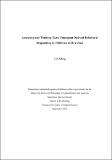| dc.description.abstract | Many children with autism fail to develop generative language despite intensive teaching; their language can be described as “rote”. Research in the area of derived stimulus relations, in particular Relational Frame Theory (RFT), suggests that derived relational responding (DRR) is the key process involved in generative language and that training children to be able to do DRR might remediate deficits in generative verbal behavior. However, there has been little research done with individuals with very limited or no pre-existing repertoires of DRR. This thesis thus focused on the assessment and training of three early emergent patterns of relational responding in such populations: coordination (sameness), distinction, and class inclusion. It was decided to focus on relations that included both auditory and visual stimuli since these are likely particularly important in the development of conversation and early language. In accordance with RFT, deficits were addressed using multiple exemplar training (MET).
The first line of research (Chapters 5 and 6) involved assessing and training derived coordination with individuals with very early language repertoires. The effect of instructional context on DRR was examined across several studies, including one which used a reversal design, and provided the first ever demonstration of a reversal effect with respect to the emergence of DRR. This line of research thus identified instructional context as an important consideration for assessment and training, particularly when working with individuals who have limited repertoires of DRR. MET in the context of a game about familiar animals and their names and sounds was then used to establish combinatorially entailed intraverbal responding with two individuals with autism who were not previously able to demonstrate combinatorial entailment even within this very familiar context. Notably, this was the first such demonstration with individuals with limited language skills. Apart from coordination, another pattern of early emergent relational responding is distinction. Hence, in the current thesis, same/difference relations were the next focus. Chapter 7 presented a cross-disciplinary literature review of the same/different literature, while Chapter 8 presented empirical research featuring both same and different relations as well as their derived combination. In this research, MET (in the context of a game about animals and the food they like) was used to establish DRR; these skills further generalized to a simple test of reading comprehension. Distinction has been the subject of very little previous applied work, and the research in this thesis is the first to establish a new repertoire of DRR in a frame of distinction as well as demonstrate generalization of the skill to an academically-relevant context. The third line of research (Chapter 9) provided the first demonstration of the effectiveness of MET in establishing generalized class inclusion, an important nonarbitrary foundation for advanced ‘hierarchical’ DRR relevant to categorization.
Findings provided further support for the contention made by RFT that DRR is a learned operant, and provided important evidence of the effectiveness of MET in establishing repertoires of DRR with individuals who have limited language skills. In addition to the theoretical implications of the work, there were also significant practical implications. In all three lines of research, new methods for assessing and training early repertoires of DRR were developed that can easily be implemented by practitioners in the course of typical early intervention programs, either in tabletop formats or in an easily managed iPad app. The technology of derived stimulus relations research must be able to be disseminated to practitioners if it is to have the socially significant impact many researchers hope for, and the studies and reviews that form this thesis have provided another step towards that goal. | en_IE |


